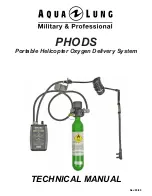
LISST-
Tau User’s Manual
Appendix E: Measurement Description
Page 27
Appendix E: Measurement Description
The LISST-Tau follows a common direct-path collimated beam transmissometer design
comprising an open sample volume flanked with two pressure windows, the first allowing a
collimated beam to enter the sample volume, and the second allowing the transmitted beam
to be measured. The transmit optics assembly consists of an LED combined with a pinhole
to approximate a point source, a collimating lens, spectral bandpass interference filter, and a
beam-splitter with reference photodiode to measure the beam power entering the sample
volume. The receive optics consist of a focusing lens, pinhole, and transmitted power
photodiode. The receive optics are designed for an acceptance angle of
~1.0°
, half-angle in
water. For ambient light rejection, the source LED is modulated on-off at
kHz
frequency and
the net signals are considered. Beam transmission through the sample volume is defined as
the ratio of power received (
Φ
𝑆
, units
W
) to the power entering the sample volume (
Φ
𝑅
, units
W
), measured by the reference detector.
The net (difference between LED on and LED off value) measurements from the two
photodiodes with front-end amplifier circuits and analog to digital conversion are,
Φ
𝑆
= 𝐺
𝑆
(𝑉
𝑆
− 𝑉
𝑆0
)
Φ
𝑅
= 𝐺
𝑅
(𝑉
𝑅
− 𝑉
𝑅0
).
𝑉
𝑆
and
𝑉
𝑅
are the net signal (transmitted) and net reference, in digital counts;
𝑉
𝑆0
and
𝑉
𝑅0
are
“dark” offsets that may be present in the electronics, also in counts.
𝐺
𝑆
and
𝐺
𝑅
are scaling
factors relating the digital counts to radiant spectral flux (units of
W count
−1
). The dark
offsets are slowly varying in time and considered to be system constants stored in firmware.
The scaling factors
𝐺
𝑆
and
𝐺
𝑅
are also system constants that are obviated through the
process of pure water calibration (see below).
Raw uncorrected transmission (unitless) is calculated using the digitized signals as
𝜙 =
𝑉
𝑆
− 𝑉
𝑆0
𝑉
𝑅
− 𝑉
𝑅0
,
and, again, beam transmission is defined as the ratio of received (transmitted) to reference
power,
𝜏 =
Φ
𝑆
Φ
𝑅
=
𝐺
𝑆
𝐺
𝑅
(𝑉
𝑆
− 𝑉
𝑆0
)
(𝑉
𝑅
− 𝑉
𝑅0
)
= 𝐺𝜙,
and depends on the pathlength
𝐿
through which the beam is attenuated (
𝐿 = 0.15 m
for the
LISST-
Tau). According to Beer’s Law, the beam attenuation coefficient (units of
m
−1
) is then
defined as
𝑐 = −
1
𝐿
ln(𝜏) ,
where
ln(∙)
is the natural logarithm. Furthermore, beam attenuation is the sum of attenuation
due to pure water (
𝑐
𝑤
) and all of the suspended and dissolved material other than the water
(
𝑐
𝑝𝑔
),
𝑐 = 𝑐
𝑝𝑔
+ 𝑐
𝑤
.
Most often we consider beam attenuation and transmission measurements in terms of the
substances other than water, i.e.,
𝑐
𝑝𝑔
= 𝑐 − 𝑐
𝑤
ln(𝜏
𝑝𝑔
) = ln(𝜏) − ln(𝜏
𝑤
) = ln (
𝜏
𝜏
𝑤
) ,



































